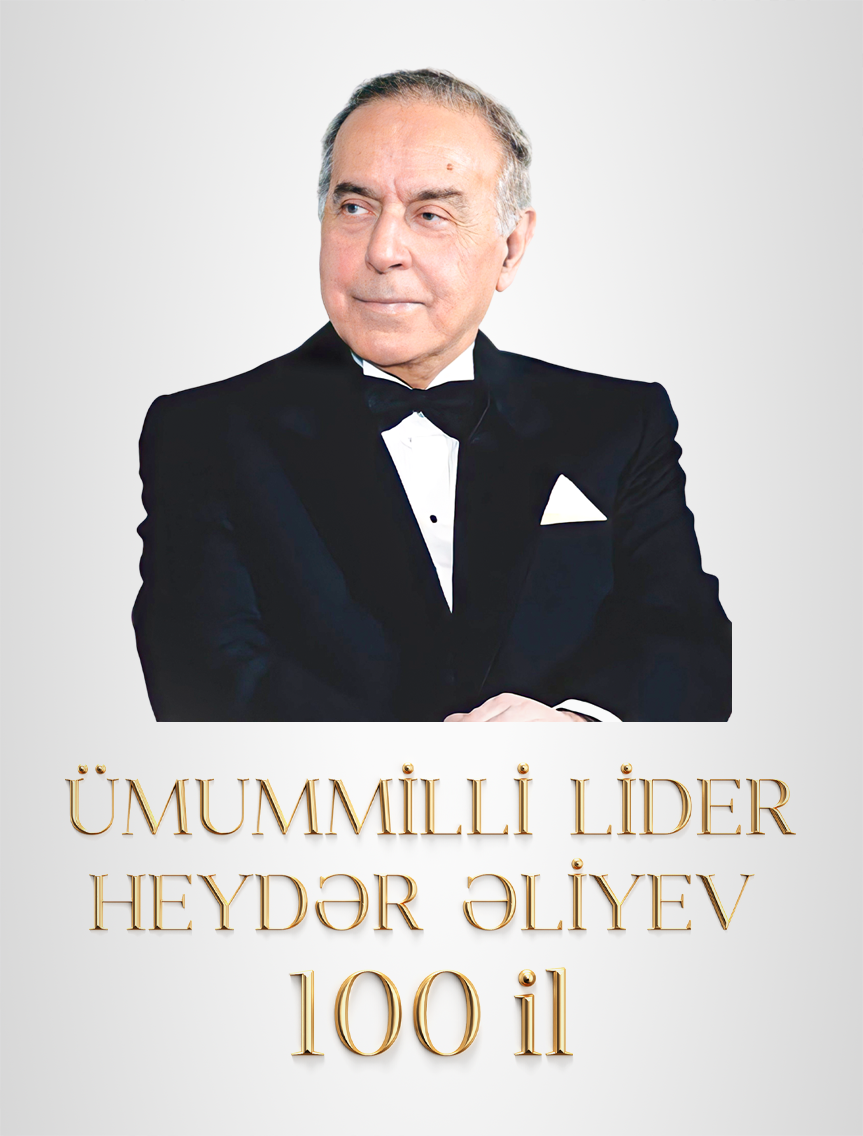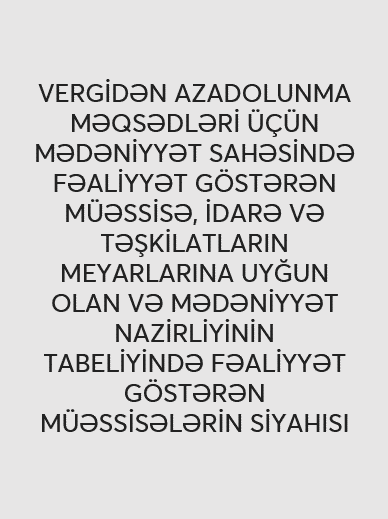CULTURE
AZERBAIJANI FOLK ART
CARPET WEAVING IN AZERBAIJAN
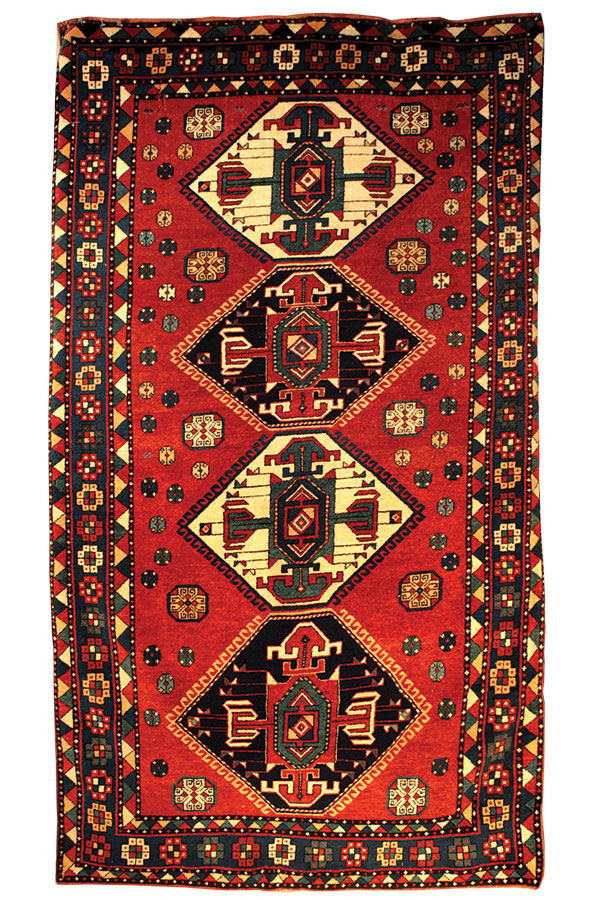
Azerbaijani folk-applied art and its branch-carpet weaving occupy a special place in the history of the national culture of the people.
The most widespread type of folk art is the art of carpets, which occupied a strong place in the life of the Azerbaijani people and almost became the symbol of the people. Fleecy and pileless carpets, decorated with various elements and drawings, are used in wall decoration and laying of beds, tents, alachigs, as well as residential houses and other buildings, and are of high aesthetic importance at the same time.
According to archaeological materials and written sources, carpet weaving was engaged in Azerbaijan even from the Bronze Age. (before the end of the II millennium BC -at the beginning of the I millennium). The city is associated with enthusiastic people from around the world who have enjoyable. Hey. (II millennium BC), a Chul picture decorated with flower images was discovered on the Hasanli Hill near Lake Urmia of golden glass ( I millennia BC) the description of the glaze covered on the surface and other findings show the ancient history of carpet art in Azerbaijan. Remains of Palas and carpets belonging to the I-III centuries were found during archaeological excavations in Mingachevir from catacomb graves.
Herodotus, Claudius Elian, Xenophon, and other ancient historians of the world gave information about the development of carpet weaving in Azerbaijan. In the period of Sassanids (III-VII centuries) carpet art developed in Azerbaijan, exquisite carpets were woven from silk, gold, and silver threads. Albanian historian Musa Kalankatli (VII century) informs about silk fabrics and colorful carpets woven in Azerbaijan. The production of carpets woven with gold-silver threads and decorated with brow Stones became traditional in the XVI-XVII centuries. In the Middle Ages, the main production centers of pileless carpets woven from gold and silver threads were the cities of Tabriz, Shamakhi, and Barda. Such carpets, which were mainly woven for feudal lords, were called "Zarbaf" because of their high cost. English traveler Anthony Jenkinson, who visited Azerbaijan in the XVI century, informs about carpet woven with gold and silver threads in Abdulla Khan's summer residence in Shamakhy. Yan Streits, a Dutch traveler of the XVII century, says that the Chul laid on the Shamakhy judge's horse is decorated with golden threads and pearls and precious stones.
Interesting information about Azerbaijani carpet products and their artistic features is found in written sources of the Middle Ages. In the work "Hudud al-Alam" ("borders of the world") of the X century, an unknown author informs about the palas and chules woven in Mughan, Zili carpets of Nakhchivan, silk carpets of Azerbaijan in the epos "Kitabi-Dada Gorgud", fleecy and fleeceless carpets in the works of Abul Ula Ganjavi, Nizami, Khagani (XII century).
In the XIII-XIV centuries many carpets and carpet products were exported from Azerbaijan to foreign countries. These carpets, attracting attention with their delicate ornaments, delicate and delicate patterns, are reflected in works of famous European artists, miniatures. In the work of Dutch painters of XV century Hans Memling "Maryam with her baby" Shirvan carpet, in the work of Van Eykin "Saint Maryam" "Zeyva carpet", in the work of German artist Hans Holbein (XV Century) "Ambassadors" "Gazakh" carpet were depicted.
In the second half of the XVIII century, the north of Azerbaijan began to be divided into small feudal — Sheki, Baku, Guba, Karabakh, Irevan, Ganja, Nakhchivan, Shirvan khanates. In the period of khanates, carpet production was greatly expanded and each Khanate had its own carpet-making quarry. The development of carpet weaving in the period of khanates paved the way for the formation of the name of carpet weaving schools in the future.
The best samples of carpets and carpet products brought from Baku, Guba, Shamakhi, Ganja, Sheki, Gazakh, Javad uyezd, and other places were demonstrated in Moscow in 1872 at Moscow Polytechnic and in 1882 at the all-Russian industrial and art exhibition were awarded gold and silver medals. The main part of the exhibits displayed at international exhibitions organized in Vienna (Austria) in 1872, Turin (Italy) in 1911, London and Berlin in 1913 were carpets and carpet products from Azerbaijan.
Types of fleeceless carpets. According to their technical characteristics, Azerbaijani carpets are fleecy and fleeceless. Fleecy carpets date back to the earliest period of weaving.

Azerbaijani carpet art differs due to its high artistic technical quality and variety of fleeceless weaves. Here are presented all samples of fleeceless carpets, and in the carpet art of other countries, these patterns are represented in small quantities. In this regard, German art critic G.Rop proves that in the section" Caucasian carpets "of the book" oriental carpet " carpets here originate much earlier than Asian carpets, and pileless carpets — kilims are the best in the Caucasus. The basis of the creation of pileless carpets and carpet art, in general, is their first simple examples- woven, cheten, buriya. Pileless carpets are divided into 8 types that differ from each other according to their weaving method, composition structure, ornament richness, and color.
- Palaz
- Cecim
- Ladi
- Kilim
- Shadda
- Varni
- Zili
- Sumakh
Azerbaijani carpet weaving schools. As an art area, Azerbaijani carpets are conditionally divided into 7 carpet-weaving schools due to their geographical location, patterns, Composition, Color Solution, and technical features:
1. Guba
2. Baku or Absheron
3. Shirvan
4. Ganja
5. Gazakh
6. Karabakh
7. Tabriz
1. Guba Carpet Center located in the north-east of Azerbaijan is divided into three parts — mountainous, Foothill and lowland. Centralized points in Gonagkand, Khashi, Jimi, Afurja, Yerfi, Budug, Giriz, Jek, Salmasoyud villages can be attributed to the mountainous part.
Carpet production in the foothills is carried out in Amirkhanli, Alikhanli, Khalfalar, Piramsan, Bilij, Shahnazarli, Pirabadil, Zeyva, Zohrami, Sumagobag, Khirdagul-Chichi, backpack-Chichi, Dere-Chichi villages, and in the lowland, Shabran Aran zone, Chay Garagashli, Haji Garagashli, Susanli, Garagashli, Devechi, Mollakamalli, and others. and in the towns. This school also includes carpets woven in Derbent.
The decoration of Guba carpets is stylized plant ornaments consisting of geometric patterns, and sometimes animal motifs. The medallion style is also widely used in the carpets of this school. The most striking compositions of Guba carpets are "Gadim-Minara", "Qimil", "Alpan", "Gollu-Chichi", "Pirabedil", "Hajigaib", "Giriz", "Jack" and others.- is.

2. Baku school includes Absheron villages-Goradil, Novkhani, Nardaran, Bulbula, Fatmai, Mardakan, Gala, Khila, and other villages, as well as Khizi district located outside Absheron and Qadi, Hil, Kesh, Findighan, and others. it covers carpet areas. Baku carpets are distinguished for their softer color intensity, originality of artistic elements, and subtlety of patterns. Geometrical-shaped lakes and curved-line botanical elements prevail in the ornaments of carpets. In the color range of Baku carpets, mainly dark blue, in rare cases, red and yellow colors are used for the intermediate area location. Most of these carpets bear the name of the village where they are woven. Baku Group includes "Khilabuta", "Khila-Afshan", "Novkhani", "Surakhani", "Gala", "Baku", "Goradil", "Fatmai", "Findighan", "Qadi" and other condiments are included.
3. Shirvan carpet school. It covers Shamakhi, Maraza, AGSU, Kurdamir, Gazimammad (Hajigabul), Goychay, and their surrounding villages. Shirvan group includes "Maraza", "Gobustan", "Shirvan", "Kurdamir", "Shilian", "Shirelibey", "Chukhanli", "Bijo", "Sor-Sor", "Hajigabul" and others. includes compositions. Rich and intricate patterns of Shirvan carpets have been popular since the Middle Ages. German, English merchants and ambassadors of the VI-VIII centuries provided valuable information on the art value of Shirvan carpets in their diaries. These carpets were praised in the paintings of European artists in the XIV-XV centuries. Dutch artist Hans Memling (XV century) in his work "Maryam with her baby" depicted the "Shirvan" carpet.
4. Ganja carpet-weaving school covers the territory of ganja city and its surrounding villages, Gadabay and Goranboy, Shamkir, and Samukh districts. The center of this school is a little town. Ganja, one of the ancient cities, is located in the northwest of Azerbaijan. Ganja was known as a center of production of silk, wool fabrics, silk carpets in the X-XI centuries. For centuries, there were special carpet workshops in Ganja, a center for the production of high-quality carpets. Ganja carpet-making school had a positive impact on the carpet-making of the regions around Ganja.
Ganja carpet school includes "Ganja", "ancient Ganja", "Golkand", "Fakhrali", "Chaykand", "Chayli", "Shadili", "Chiragli", "Samukh" and others. includes compositions. "Fakhrali" prayer carpet belonging to Ganja group differs from other carpet compositions for its high artistic feature and touch.
5. Gazakh carpet-making school is located in Gazakh, Borchali, where Azerbaijanis lived in Georgia, and Goycha carpet-making centers in Armenia, where Azerbaijanis lived until 1988.
Gazakh Carpet Center includes Gazakh and its surrounding villages, Agstafa, and Tovuz regions of Azerbaijan.
Goycha Carpet Center is surrounded by the territory around Bambak, Lambali, Ijevan, Garagoyunlu, and Goycha lake (now Sevan), and Borchali carpet center includes Borchali, Garayazi, Garachop, Gachagan carpet points.
To the Kazakh group, "Shikhli", "Borchali", "Gaymagli", "Garagoyunlu", "Garayazi", "Garachop", "Gachagan", "Dagkesemen", "Demirchilar", "Kemarli", "Goychali", "Salahli" and others cheshnili carpets included.
A harmonious coloration is created in the carpets of these schools with little colors. Patterns of ganja-Gazakh carpets attracted the interest of European artists even in the Middle Ages, the images of "good news" by Carlo Krivelo, Italian painter of XV century, "messengers" by Hans Holbein (XV century) of German painter were described.
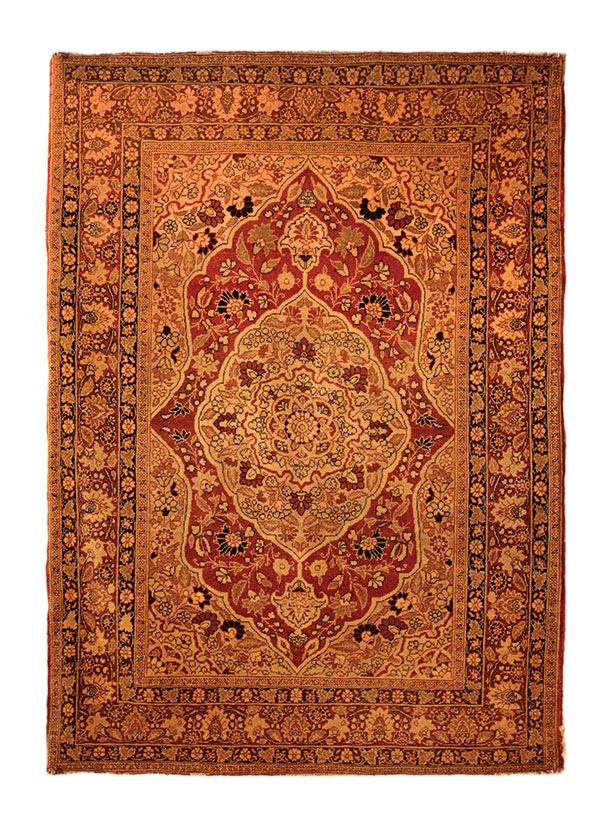
6. Karabakh carpet school, located in the southwest of Azerbaijan, has developed in two regions — mountainous and lowland zones. In written sources, Shusha City and villages of Dashbulag, Dovshanli, hostage, Trniviz, Malibeyli, Chanakhcha, tug, Tuglar, Hadrut, Muradkhanli, Gasimushagi, Gubadli, Gozag, Mirseyid, Bagirbeyli, Khanlig, Tutmas played a major role in carpet making in XIX century in the mountainous zone of Karabakh, which was mentioned by Arab historians Al-Sacred, Masudi and b. as a large Craft Center engaged in wool and cotton processing since X century. Of course, in low-lying areas, where raw materials are provided better than in the mountainous regions, Jabrayil, Agdam, Barda, and Fuzuli occupy the main place in carpet production. There were a lot of villages in each of these centers where people were intensively weaving carpets for sale. In terms of their artistic structure, technological features, color solutions, Zangazur, and Nakhchivan carpet production centers are also included in the Karabakh carpet school. "Aran", "Baghadagullar", "Balig", "Buynuz", "Barda", "Bahmanli", "Karabakh", "Goja", "Gasimushaghi", "Lambarani", "Mughan", "Talish", "Lampa", "Malibeyli", "Khangarvand", "Khanlig", "Khantirma", "Chalabi", "Shakhidbuta", etc. cheshnili carpet compositions are one of the classic examples of Karabakh carpet-making school. A set of 5 carpets adapted to the interiors of the houses in Karabakh is widely spread.
In the early 1750s Panahali Khan of Karabakh laid the city of Shusha. The city was originally called Panahabad and for many years became the capital of the Karabakh Khanate. In the XVIII century, Garabagh carpet-weaving school was concentrated in Shusha. In the XVIII century, along with classical carpets, new carpet compositions — "Baghadagullar", "Saxsidagullar", "Bulud" and others were woven from the patterns taken from the collection, fragrant soap, fence, and other household items brought from Russia and Europe. The color palette of Karabakh carpets is very rich. This palette reflects the most elegant shades of all colors of Karabakh nature. Since ancient times, the middle field area of Azerbaijani carpets has been traditionally worked in red color. In addition to various plants, colors were obtained here from the Middle Ages. The most common in them to get a red color is cachenil. Among the people he was called "insect of red", "red worm", "chick of Oak".
7. The peace treaty concluded between Russia and Iran on February 1828, 10, in the village of Turkmenchay near Tabriz, entered history under the name of the Turkmenchay treaty and ended the Russian-Iranian war of 1826-28. Under the terms of the treaty, the northern part of Azerbaijan joined Russia. The southern part of the country, including Tabriz, Ardabil, Urmia, Khoy, Maragha, Marand, Maku, and other cities, was enslaved by Iran. Thus, Azerbaijan was divided into 2 parts. Since that time the term "South Azerbaijan" has appeared. Since then, carpet samples of Tabriz carpet school have been known as Iranian carpets all over the world.
Tabriz carpet school is the oldest and most famous carpet school in Azerbaijan and covers Tabriz, Ardabil, Maragha, Marand, Maku, Khoy, Urmia, Zanjan, Gariga, Heris, Sarab, Ahmedabad, Mirish, Ahar, Salmas, Goravan, Senna, Garadagh and other carpet points. Turkish-speaking tribes who lived in this area played an important role in the formation and development of carpet weaving since ancient times and had a serious impact on the formation of Iranian carpet art at different times. In the Middle Ages, trade relations with the most important shopping centers and rich cities of the East, as well as with Europe, led to the rapid development of the art of carpet weaving. Tabriz carpet school, which is already in bloom in the XI-XII centuries, mastered the artistic features of the Tabriz miniature school in the XIII-XIV centuries, reached a high stage of development in the XVI-XVII centuries. Pileless and fleecy carpets belonging to this school are distinguished by Artistic Design, Color Harmony, and a variety of ornamental decorations. Tabriz carpet school is divided into 2 groups according to the main carpet compositions: Tabriz and Ardabil groups. The Tabriz group includes compositions "Tabriz", "Bakhshayish", "Gariga", "Goravan", "Heris", "Petachturunc", "Afshan", "Agajli", "hunting", "four chapters", and "Ardabil", "Sheikh Safi", "Shah Abbasi", "Sarabi", "Zanjan", "Mir"and "Achma-yumma". "Bag-Paradise", "bag-forest", "Balig", "Buta", "Dervish", "Ketebali", "Gordastet", "gollu-gushali", "Guldanli", "Leyli and Majnun", "Mashahir", "Mun", "Namazlig", "Najagli", "Sarvistan", "Sardari", "Sahand", "Syvi petal", "Farhad and Shirin", "Khayyam", "Khayyam Khatai", "Ashad", "Charkhi-Gul", "jeyranly", etc. classical compositions are also popular. The famous carpet "Sheikh Safi" (size 56,12 sq. m, 1539, "Victoria and Albert" Museum, London) the most beautiful example of ornamental carpets is the masterpiece of Tabriz School of carpet weaving.
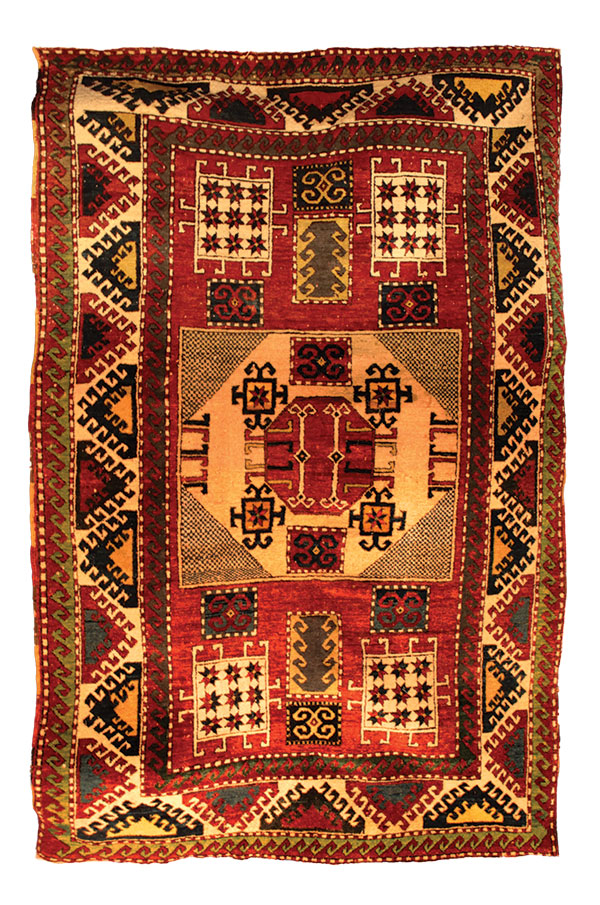
The development of carpet weaving in the XX century. The period of further development of Azerbaijani carpet art dates back to the middle of XX century. During this period, the development of Azerbaijani carpet art continued in several directions and was multifaceted. Carpet art traditions in the regions and villages of the Republic are continued by different carpet Masters. Their creative attitude to classical compositions is evident in the carpets woven by traditional varieties. At the same time, new compositions and elements of patterns appear in carpet weaving. In the newly created fountains, the tendency to floral patterns with relatively curved lines, human, animal, bird images, plot compositions created in lyrical and romantic styles is superior. Another branch of the development of carpet art is the activity of "Azerkhalcha" production Union. Carpets woven in workshops and workshops of"azerkhalcha" include traditional patterns, lakes and colors, creative variations made by masters increase and enrich the number of classic carpet compositions.
Another branch of carpet art is continued and developed by professional artists. Carpets woven on the basis of new ornaments and patterns created by them are of great importance in enriching classical compositions.
Despite the violation of classical canons in the composition, painting solution and color of these carpets, various artistic and technical means help to reveal the subject.
Important measures have been taken to develop carpet-weaving in Azerbaijan. As for the art and science of carpet weaving. And ad. He is taught in Azerbaijan State Art School, Azerbaijan State University of Culture and art, as well as in art-oriented colleges. Carpet weaving as art is taught in vocational schools, children's art galleries and other places.
The study of Azerbaijani carpet art as a science and its modern development in professional artists ' creativity is connected with the name of people's artist of Azerbaijan Latif Karimov (1906-1991). Latif Karimov, a skilful connoisseur of Oriental, including Azerbaijani carpet and decorative-applied art, a prominent ornamentalist-artist, researcher, studied Azerbaijani carpets for many years, enriched Azerbaijani decorative art with new ornaments, and created new decorative motifs based on traditional decorative elements. Woven on the basis of Latif Karimov's sketches “Afshan" (1932), "Gonagkand" (1939), "Petachturunj" (1952), "Shusha" (1953), "Goygol" (1958), "Garabagh" (1960), "Islimi" (1964), "Butali" (1965), "Bahar" (1966,1976), "in the animal world" (1969), "Shabi-hijran" (1975), "Zarkhara" (1977), "Firdovsi" (1934), "Samad Vurgun" (1956), "Vagif" (1967), "Fuzuli" (1972), "Nasimi" (1974), "Safiaddin Urmavi" (1975), "Ajami" (1976) and others. ornamental and portrait carpets are valuable examples of carpet-weaving art due to the harmony of ornament elements, compositional vegetation, elegance and expressiveness of paintings, and rich color. In 1949, he was awarded the USSR State Prize in 1950 for his "Stalin" carpet created together with collective authors. His personal exhibition opened in London in 1986 was successfully exhibited by the artist "Dami-Rumi" (1980,1981), "Petalturunc" (1981), "Khatai" (1981,1985), "Achma-yumma" (1982), "Petal-Yumma" (1983), "Ketebabantlik" (1984), "song of the ages" (1985) and others. carpets were displayed.In Latif Karimov’s multi-volume work" Azerbaijani carpet", more than 1,300 elements of Azerbaijani carpet ornaments are analyzed.
The development of carpet weaving in modern times
In 2010, Azerbaijani carpet art was included in UNESCO's "representative list of the intangible cultural heritage of humanity". The Azerbaijani art of mugham was supported by the attention and care of President Ilham Aliyev to the culture of our people and promotion of our cultural heritage, and thanks to the initiative and work of President of the Heydar Aliyev Foundation, UNESCO, and ISESCO goodwill ambassador Mehriban Aliyeva and the fact that our national carpet art is on this list after the Azerbaijani ashug art is another successful step towards promoting our culture on an international scale in general.

Today, carpet art in Azerbaijan is experiencing a new stage of its development. The adoption of the law on protection and development of Azerbaijani carpet art", the construction of a building in accordance with modern standards for the State Museum of Azerbaijani Carpet and Applied Art by the order of President Ilham Aliyev is an expression of state care for this ancient handicraft.
The Carpet Museum, which has been operating since 2014, contributes to the promotion and recognition of Azerbaijani carpets worldwide. Examples collected in the museum meeting modern requirements include the history of our people. More than 13,300 exhibits and items are stored in the exhibitions and funds of the carpet museum, reminiscent of the original style of wrapped carpet, which reflects the development of this type of art in different periods. The museum also contains a copy of the famous "Sheikh Safi" carpet kept in the Victoria and Albert Museum of Great Britain, as well as famous compositions woven in XVII, XVIII, XIX, and XX centuries. As a result of the measures taken by our state in recent years to return the Azerbaijani people's wealth stored in foreign countries, the collection of the Carpet Museum has become even richer. Thus, according to the paragraph "Creating conditions for the return to the country of rare Azerbaijani carpets stored in museums of foreign countries," in Article 4.1.4 of the Decree of Mr. İlham Aliyev of 07.12.2004 "On the Law of 07.02.2005" On the Preservation and Development of Azerbaijani Carpet Art "and on the application of this law, the museum is promoted in the international arena. As a logical result of successful works two Azerbaijani carpets — "Ajdahali" (Karabakh, end of XVII century) and "Salyan Xyleni" (Shirvan, XIX century) from the collection of late Grover Shilts, a member of Chicago (USA) Society for oriental carpets and textiles were presented to the museum. This event means the restoration of one of the important pages of the history of Azerbaijani carpet art.
The fact that our natural, material, and cultural monuments were plundered and “captured” in connection with the occupation of our lands by Armenian occupiers is irrefutable. Some of them were taken by our compatriots living abroad and returned to their homeland. “Bakhchadagullar” carpet of Karabakh group with unusual history is kept in pile carpets collection of Azerbaijan Carpet Museum. In February 2017, a US citizen Elshad Tahirov, a native of Azerbaijan, saw a carpet on the website of the virtual art trade. It should be noted that E.Tahirov loves to collect books about Azerbaijani carpets and works of Latif Karimov, an outstanding scientist, carpet-Painter, founder of Azerbaijani carpet-making, and often searches for interesting works of art and information on the internet. This time it was mentioned in the article describing the carpet, which attracted the attention of the Collector: “ancient Armenia. Karabakh carpet" However, the inscription “gift from mother to Sarvar's birthday on January 1, 1979” woven in Cyrillic alphabet in Azerbaijani language proves that this item belongs to Azerbaijan and it is concluded that the carpet was taken out of our country by Armenian invaders. After a quarter of a century, Elshad Tahirov bought this carpet at the auction and sent it to the Azerbaijan Carpet Museum in May 2017. Although E.Tahirov tried to find the owner of the item, he could not achieve this and presented the carpet to the museum. It should be noted that this is the first carpet returned from the Armenian occupation after many years.
In 2015, on July 15, the opening of the exhibition “Azerbaijani carpets in art” took place at the festival's Palace of Cannes. Works by Azerbaijani artists Latif Karimov, Vugar Muradov, Butunay Hagverdiyev, and Elchin Valiyev – modern, pop-art works and installations based on national carpet sketches were presented at the exhibition.
In 2016, by the Order of the president of the Republic of Azerbaijan dated May 5, “Azerkhalcha” Open Joint Stock Company was established. The main purpose of the company is to produce and export carpets and carpet products, to organize their sale in the country and abroad, to apply new technologies in the production of carpets and carpet products, to modernize the material and technical base, and to use it effectively, as well as to carry out other works related to the development of this field. At the initial stage it was planned to establish branches of "Azerkhalcha" OJSC in Fuzuli (Horadiz), Agdam (Guzanli), Tovuz, Agstafa, Gazakh, Shamkir, Guba, Ismayilli, Khachmaz, and Gabala regions. In 2016-2017, the construction of buildings in these districts was completed, branches started to function, training and preparation courses on carpet weaving of "Azerkhalcha" were organized, relevant measures were taken to strengthen the working capacity.
NATIONAL CLOTHES OF AZERBAIJAN
The national costume of Azerbaijan is the result of the material and spiritual culture of the people, which has passed a long and very complex way of development. Clothing, firmly connected with the history of the people, is one of the valuable sources for studying its culture. Clothing is one of the most stable ethnic features, reflecting the national character of the people more than any other element of material culture. Playing an important role in identifying ethnogeny, cultural and historical relations, the mutual influence between nations, clothes are also influenced by economic and geographical conditions.
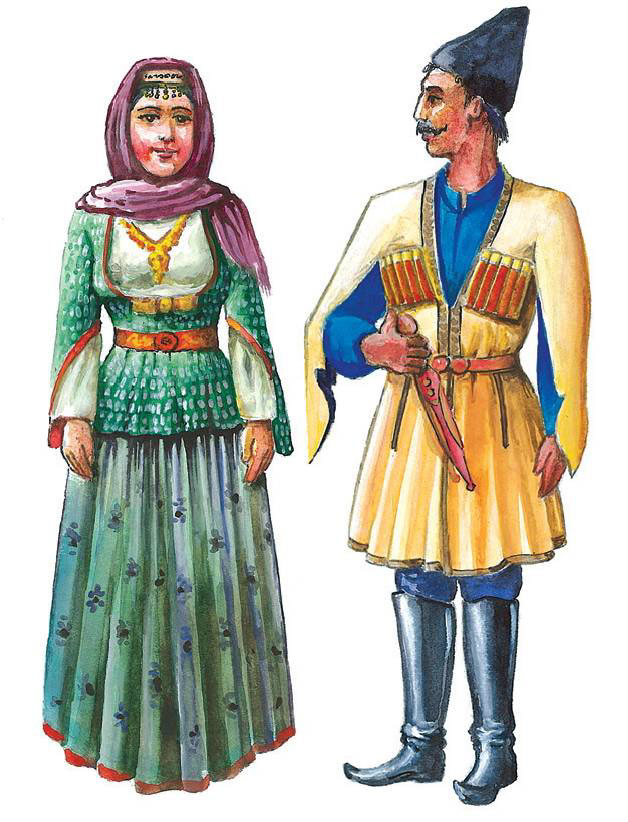
Historical, ethnographic, and artistic features of folk art are reflected in clothes. It may be apparent on clothing and accessories, as well as on embroidery and weaving art.
During archaeological excavations in Azerbaijan, bronze needles and awls dated to the Early Bronze Age (3rd millennium BC) were discovered. These findings prove that the ancient population of Azerbaijan could sew clothes for themselves. Small clay statues (2nd millennium BC) found in Kultepe and seals and fingerwares (5th century BC) discovered in Mingechevir give a certain idea of garments of that period. Remains of clothes made of silk fabrics were found in Mingechevir catacomb graves (5-6th centuries AD). Gold accessories and clay shoe shape dishes dated back to the 3-4th century also prove that the Azerbaijanis had high material culture since ancient times.
During restoration works in a mausoleum next to the Shirvanshah Palace (15th century) in Baku, remnants of valuable moire and silk fabrics were found.
Abundant raw materials in Azerbaijan created favorable conditions for manufacturing silk and woolen clothes here in the Middle Ages.
In the 17th century, Azerbaijan was an important sericulture region of the Near East, while Shirvan was the main sericulture province of Azerbaijan. Shamakhi Shabran, Arash, Gabala, Javad, Agdash, and other cities were Azerbaijan's main textile centers. The famous traveler Adam Olearius wrote: "They (Shirvan people) are mostly engaged in yarn, silk and wool weaving, embroidery." Textiles manufactured in Shamakhi became well known since there was a constant demand for elegant headcovers and other weaving products.
Ganja, Sheki, Nakhchivan, Maragha, Marand, Arash, and Ordubad were important textile centers. An important silk textile center, Ganja should especially be mentioned. Evliya Chalabi (XII century) wrote that the Ganja silk was very popular. The production of the cotton fabric also played an important role in the existing handicrafts in Ganja.
The production of various types of fabrics was concentrated in Tabriz. The city was especially famous for the production of high-quality velvet, satin, fabric, and keji (thread made of cooked cocoon). Some of these fabrics were even exported to other countries.
Skillful weavers of Nakhchivan manufactured inexpensive, but beautiful cotton fabrics of high quality, which were widely demanded. There was a great demand for the colorful chintz (multicolored cotton fabric with a glazed finish) they made.
Thus, in the XVII century, some specialization appeared in the field of fabric production in Azerbaijani cities continued in subsequent centuries. Among the fabrics produced and widely used in Azerbaijan and exported to other places, such as zarbaft (fabric mixed with gold), khara (bright silk fabric with patterns), atlas, taffeta, ganovuz (an elegant silk fabric, mostly colorful), kamkha (a type of patterned silk fabric), kiseya (thin transparent fabric), velvet, darayi (dense fabric woven from thick silk thread), mahud (printed wool or semi-woolen fabric on the upper side), shawl, tirma (precious woolen shawl fabric woven from wool or silk in the East), mitgal (stiff thin cotton fabric), bez (thick cotton fabric), etc. it should be noted. Some of these fabrics were popular among the people under the names "Look at me, pilgrim", "Day and night", "Stand aside", "Burnt inflame" etc.
Undoubtedly, the fabric is one of the elements reflecting national culture. Patterns and colors of fabrics distinguished one nation from another, also different classes and groups within the same nation. In Azerbaijan, ganovuz, darayi, mov, zarbaft, khara (moire), satin, velvet, taffeta, fay (dense silk or wool fabric with transverse and fine stripes), tirma (fine hand-woven wool), and other fabrics were widely used among the population.
While women's clothing was mainly made of silk and velvet, men's clothing was mostly made of mahud and homemade shawl fabric.
Both men's and women's underwear were made of linen and cotton. However, in wealthy families, underwear was often made of silk.
The XVI and XVII centuries were rich in development for Azerbaijani clothes.
Researches show that a real school of national clothing was created at that time. A person's age, occupation, and social status could be identified by his or her costume. Among the Azerbaijani costumes of the XVI century, the most interesting were the headdresses.
It is known from history that in the XVI century Azerbaijanis were called "Gizilbashlar"(Redheads) in reference to their red headgear. They wore a thin and high red cap and wrapped it with yellow fabric around it. Royalty and high-ranking military personnel adorn the turban with twelve stones or decorate it with golden lines.
The headwear has worn by high-ranking nobles sometimes had a large and valuable jewel in the center and a relatively small amount of jewels around it. Here, the big jewel is a sign of the Prophet Muhammad or Ali, and the small jewels are a sign of the 12 imams. (twelve-gored cap, symbolizing the twelve Shiʿite imams)
The famous Uzbek scientist who studied the headdresses of the Safavid period Q.A.Pugachenkova and the German scientist H. The Hots proved that their headdresses changed their shape several times, starting from the beginning of the XVI century till the end of the century. According to them, from the beginning of the XVI century until 1535, this headwear continued, and from the second half of the XVI century, it began to decrease. This type of headwear, which was fashionable till the end of the XVI century, was especially widespread in Tabriz, Nakhchivan, and Shamakhi cities.
In the XVI century, along with sharp tip red turbans, there were also ordinary non-decorated turbans in Azerbaijan.
At that time, the most common turbans were white. The Shah, vizier, or high-ranking priests would put green ones.
In the XVI-XVII centuries in Azerbaijan, along with the chalma, there were hats similar to the original small hat.
In the XVI-XVII centuries, there were hats of different forms in Azerbaijan. Among them, hats sewn from sheepskin are relatively widespread. They wore it mainly in areas engaged in cattle breeding and sheep breeding.

In the XVI-XVII centuries, women's headgear is also different in Azerbaijan. According to the materials, it can be said that at that time there were about seven types of women's hats in Azerbaijan. These include beautiful, colorful patterned large headscarves, small narrowly patterned arakhchins (a small close-fitting cap without a brim, skullcap), hats made of fur or velvet tied under the chin.
One of the most common women's headwear in the XVI-XVII centuries was arakhchin. There were two types of arakhchin for women and girls.
Headgears were worn by women at home, in the yard, and at guests' houses. When going outside they would usually wear a white charshab (veil). Traditionally, little girls and old women were allowed to not wear charshab outside.
The upper clothes of the XVI-XVII centuries were quite diverse and colorful in Azerbaijan. At that time, top clothes developed as a continuation of mostly ancient clothing traditions. However, their decoration was gradually enriched and sophisticated. The main changes evolved in details, patterns, and decorations.
In the XVI-XVII centuries, men belonging to a relatively wealthy class of Azerbaijan wore robes with patterned laps, shoulders, and collars. These robes had two types. The first type of robe was to be worn on the shoulder.
The second type of robe, on the other hand, was a narrow half-sleeve and relatively tight at the waist.
In the 16th and 17th centuries, the traditional outer garment, the aba, was also very popular in Azerbaijan. Unlike the abas of the previous period, they sat tightly on the body, and the arms were relatively narrow. In miniatures of this century, we see that the laps of such abas were pierced with a belt.
Men wore narrow-legged trousers, which gradually widened upwards. Pants were also sewn from the material of the upper shirt, but the color was often blue or dark yellow.
Men's shoes of these centuries also had different shapes. The most common men's shoes were non-heeled (sometimes low-heeled) long neck, light boots made of soft leather.
In the XVI-XVII centuries, women's outerwear was different in Azerbaijan. However, this form of clothing reminds men's clothes of that time.
Like men, women wore long-sleeved robes to decorate their shoulders. But women's robes were simpler and less decorated with patterns.
One of the women's clothing, which was worn massively in the XVI-XVII centuries, was trousers that were long to the ankle. Like men, women's trousers were very narrow from the side of the foot and wide from the top.
Azerbaijani clothes were very colorful in the XVIII century. The formation of such independent khanates as Baku, Guba, Shamakhi, Karabakh, Nakhchivan, Ganja, Lankaran, Sheki, etc. had a significant impact on clothing. The different political and economic situations in khanates influenced changes (albeit superficially) in clothes. The changes were mostly found in textile and decorations, not in cut style and shape.
In the XVIII century in Azerbaijan, men wore a tight-fitting chukha with long sleeves. Chukha was sewn mainly from dense fabric. Depending on the person's age, the color and height "chukha" would be different.
In the XVIII century, aba was worn mainly by mullahs and respected elders.
In the XVIII century, men's footwear was also very diverse. The most common shoes for men were small flat shoes made of leather. At that time, among the wealthy people, thin leather high-neck boots were worn, and some shoes were worn by peasants from the past until the beginning of the XX century.
In the XVIII century, women's clothes were made more beautifully and elegantly. The traveler Marshall von Biberstein, who was in Azerbaijan in the late XVIII century, admired local women and their clothes.
In the XVIII century, women's outerwear consisted of a shirt, chepken(outerwear worn over a shirt), arkhalig (a long tight-waist jacket), kurdu (woman´s sleeveless jacket, usually padded or fur-lined), kuleche (pleated skirt), labbada (lined jacket over the shoulder), eshmek (lined jacket over the shoulder usually made of velvet), and bahari (ornated, lined outerwear).
Depending on their age, the color of the upper shirts worn by women was also different. Girls and women wore yellow, red, green, and older women wore white or black upper shirts.
One of the most beautiful outerwear for women of this century was the chepken (a long shirt with split sleeves with a silk ribbon sewn around the edges). It had convex parts on the sides below, called "chapig" (slit), which made the body look more beautiful and figured.
One of the most popular clothes among women was arkhalig. Arkhalig was lined as chepken and it had the long tight-waist jacket. The skirt of different widths was sewn with frill or pleat in the lower part of the waist. Some of the arkhaligs had wide and straight cuts, and there were slits on the sides.
In this century, the most beautiful women's arkhaligs were sewed in Shusha, Sheki, Nakhchivan, and Shamakhi.
One of the richest women's outerwear was kurdu in this century. The kurdu was bandaged and sleeveless. Because it was worn in the winter, fur was sewn on its neck, collar, and skirt.
Although women's shoes looked like men's shoes in the XVII century, they were more elegant and abundantly decorated. Shoes of noblewomen had outer embroidery and a silver piece with ornaments (examples of such women's shoes can be found in a number of museums in our country).
In the XVIII century, women's headwear was as diverse as in previous periods.
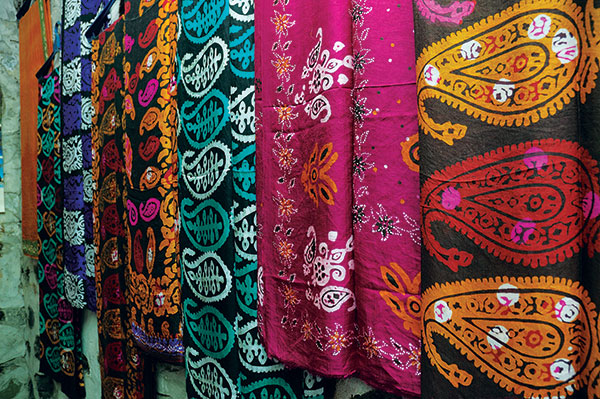
Women would use gauze and linen to gather hair together. It has also been thought to reduce perspiration (in Gashband-Nakhchivan). They were mostly made of gold, and gold coins with hooks were attached to the ends. The gauze was made of white cotton fabric, and the chargat was orange, purple, and sometimes fringed. Due to the development of sericulture, kelaghayi was mainly used, and this headdress was unique for Azerbaijanis. Embroidered with original buta patterns. The bright colors of kelaghayi were preferred. Kelaghayi can be tied in various ways. Kelaghayi was tied over a triangular headscarf after collecting hair with a piece of gauze. As a result, there would be three headdresses worn simultaneously: first, the juna (gauze), then the kelaghayi, and finally a triangular headscarf called kasaba, sarandaz, or zarbab. In cold weather, shawls (tirma shawl, kashmiri shawl, hand-woven shawl from natural wool) were put on over this clothing.
Archaeological and ethnographic studies show that the history of silk in Azerbaijan is closely connected with the emergence of the Great Silk Road.
In many works of Azerbaijani poets, silk is mentioned as a fabric worthy of kings, the most delicate feelings, the best human qualities, female beauty are likened to silk. And this is not accidental. Processed silk is distinguished by its exceptional properties due to its nature. Silk thread is very thin, but at the same time very durable, light, like air, but woven fabrics from it can be thick, heavy, and stiff. It's unbelievable, but silk is warm in the cold, cool in the heat, does not rot, is long-lasting and durable.
The transition from color to color of silk fabric pleases the eye with its slightly matte sheen, brings comfort to a person, and its rustling awakens feelings and gives wings to dreams.
The use of silk in clothes and the interior is a sign of exquisite taste and prosperity.
Kelaghayi occupies a special place among silk products in Azerbaijan.
This square-shaped silk headdress is decorated with stamp patterns and painted following the spirit of the events taking place in life. These conditions are important for the transformation of the headscarf into kelaghayi. Kelaghayi is a symbol with great ethical and aesthetic potential.
If we look at the way of life of any nation, we always come across traditional images of women and clothes, and, undoubtedly, one of the important elements of these clothes is the headscarves. Some women use a scarf to cover their heads, others throw it over their shoulders, and in some cases the scarf turns into a fabric and takes on a universal shape, covering the head, shoulders, and body.
There is a unique element in the traditional clothes of Azerbaijani women for more than three centuries — "Kelaghayi", whose name is impregnated with the ray of ancient times.

The unique and traditional women's headdress "Kelaghayi" appeared about 300 years ago. Scientists believe that this is the age of an embroidery machine preserved in the ancient village of Basgal in the Ismayilli region of Azerbaijan. The shapes and metal molds used to create hot colors and wax patterns have a 200-years old history.
The most common plots in the 19th and 20th centuries are peacock paintings, leaves, and flowers combined with intricate geometric patterns.
Kelaghayis of each region differ from each other by their ornaments: Large patterns are characteristic for Absheron and Sheki, small patterns are used in Shamakhi, and a combination of large and small patterns is used in Ganja, Gazakh, and Karabakh regions.
Every Azerbaijani knows kelaghayi from childhood. Our grandmothers for sure had a few silk scarves. The magic patterns on the delicate silk attracted the children's attention and brought them closer to the national colors and rhythms.
Today, kelaghayi is given a new breath. Kelaghayi is so well adapted to the wardrobe of modern and fashionable women that all our fashion designers use it in their collections. Our women are very happy to receive and use this traditional headscarf with unique beauty. Kelaghayi adorns even the most ordinary dress and becomes its essence.
Azerbaijani national dresses are distinguished for their originality and uniqueness. In this sense, he managed to attract the attention of the world. In 2014, the traditional art and symbolism of kelaghayi were included in UNESCO`s Representative List of the Intangible Cultural Heritage of Humanity.
One of the most common headgears in this period was arakhchin. However, these arakhchins differed from arakhchins of XVI-XVII centuries in the absence of a braid bag on the back.
In the XVIII century and later in Azerbaijan, a headdress made of "tasakqabagi" was widespread. These headpieces, which adorned most women's foreheads, were made by jewelers, not by tailors.

This type of headgear was widespread mainly in Karabakh, Ganja, Gazakh, Tovuz, and Borchali regions.
Paintings by Russian artists Vereschagin and Gagarin, who in the XIX century traveled to Baku, Shamakhi, Sheki, Ganja, Kazakh, and other cities also expressed admiration by the Azerbaijani national costume.
The territory of Azerbaijan can be divided into several historical and ethnographic regions. These include Guba-Khachmaz, Absheron, Lankaran-Astara, Shamakhi, Karabakh, Nakhchivan-Ordubad, Gabala-Oguz, Sheki-Zagatala, Ganja, and Shamkir-Gazakh zones. The same clothes worn by the Azerbaijanis in the above-mentioned ethnographic regions prove that they historically belong to the same ethnic group. Slight differences in costume reflected only local patterns of the common national clothing.
The costume reflected local peculiarities of Azerbaijan's various historical and ethnographic regions, clothes, indicating the age, marital and social status of its owner. The clothes of a young girl and a married woman were visibly different. Young women wore richer and more beautifully decorated garments. Clothes of girls and older women were less decorated.
Men's clothing was the same in the historical and ethnographic zones, as women's clothing. It was not hard to determine by his clothes what class he belonged to.
Children's clothing in shape was identical to the clothing of the elderly, differing only in size and elements of adaptation to the age characteristic.
Unlike daily and working clothes, wedding and special occasion costumes usually were made of precious fabrics and decorated with golden and silver jewelry.
Azerbaijani women's clothes consisting of upper and lower pieces dated XIX and early XX century could be divided into two groups.
The upper garments comprised upper shirt, chepken, arkhalig, labbada, kulaja, kurdu, eshmek, and bahari.
The sleeves of the women's upper shirt were mostly long, wide, and straight. The part of the arm sewn to the shoulder was mostly straight and in some cases small-pleated. Khishdek (a patch of fabric in a different color) was usually placed under the armpit. The shirt was buttoned with one button on the neck. The upper shirt was usually sewn from ganovuz or fay. The neck, collar, cuffs, and hem of the shirt were covered with yellow bafta (braided narrow ribbon for decoration). The front of the shirt was embroidered with a gold or silver coin.
Chepken was worn over the top of the shirt. It had a lining and was sewn tight to the body. On the sides, it has bulging parts named "chapig" (slit), which showed the body nicer and more attractive. There were so-called sleeves ending with so-called gloves. These sleeves were dangling loosely from the shoulder. Sometimes buttons were also sewn into this so-called sleeve. The chepken was made of tirma, velvet, and various gilded fabrics. Sarima, bafta, koba, zencire, shahpesend was sewn into the collar of chepken, to the edge of a slit, to the edges of hem, and the edges of the sleeves.
Arkhalig was the most popular costume among women in Azerbaijan. There were many types of it.
Like chepken, arkhalig also had a lining and was tight to the body. Skirts of different widths were sewn with ruffles or pleats at the bottom of the waist. Some arkhaligs were wide and straight and the side part had slits. The shape of the sleeves of the arkhalig was also different. Some were straight and long, and it was sewn in the form of a so-called arm that ended with a glove below the elbow. The third form of the arkhalig was lelufar-sleeved. The lelufar sleeve was straight to the elbow and a lily-shaped slit below the elbow. Along the hem of the sleeve, there are two finger-width pleats made of arkhalig's fabric. The collar of the arkhalig was open. In most cases, the arkhalig were buttoned from the breast to the waist. Some of them were unbuttoned at all. The arkhaligs were made of velvet, tirma, and various gilded khara fabrics and decorated with different bafta and sarima.

Lebbade was quilted and lined. The lebbade collar was open, and at the waist, it was tied with a braid. There were shortcuts on the sides just below the waist. Lebbade's sleeves were short, usually down to the elbows. Lebbade was sewn from tirme fabrics, velor, and various shiny fabrics. The collar, sleeves, and hem were trimmed with delicate bafta.
Eshmek is quilted outerwear. Eshmek's chest and armpits were cut open, and the sleeves were down to the elbows. For sewing eshmek, as a rule, they used tirme and velor. The inner part, collar, sleeves, and hem of the eshmek were trimmed with fur. In addition, baffles and chains were sewn to the sleeves, hem, and collar of the eshmek.
Kurdu is a quilted women's garment with open collars, sleeveless. It has slits on the sides. The kurdu was sewn from tirme and velor fabric. A particularly widespread type of this clothing was the so-called Khorasan kurdu, which was made of dark yellow leather with patterns embroidered with silk thread of the same color.
The bahari was a lined, quilted woman´s garment for the upper body. It was closely fitted at the waist and fanned out below the waist. The elbow-length sleeves were cut straight and the collar was left open. It was mainly made of velvet. Various bafta, koba, and chains were sewn on the collar, skirt, and sleeves of the bahari.
Kulaja is a woman's outer garment with a pleated skirt. The sleeves were straight and finished a little below the elbow while the collar was left open. The kulaja was mainly made from velvet and tirma. Different decorative techniques were used on the kulaja, including gulabatin (golden or silver embroidery), bafta (using braid or lace trims), zanjira (fine needlework), munchuglu tikma (beadwork), and pilakli doldurma (quilting).
The length of the tuman (layered skirt) worn by the Azerbaijani woman was up to the ankle, except the Nakhchivan-Ordubad zone. In the Nakhchivan-Ordubad zone, women wore relatively shorter tuman's (skirt). Tuman was made of silk or wool with different patterns. In addition to the upper skirt, the skirts worn under it were called layers of tuman. Tumans could be goffered or pleated and had a waistband at the waist. On both sides of the waistband, which was woven from goat's fur, there were tassels made of colored silk and gulabatin threads. Tumans were made of all kinds of fabrics, from chintz to tirma. Kobas, chains, and various baftas from different fabrics were sewn to the hems of tuman. In some cities, women also wore chakhchur. Chakhchur was made of various silk fabrics.
To make women's outerwear even more beautiful, there were various baftas, sarima, garagoz, zenjire, and shahpesend made at home or in craft workshops. Buttons made of gold or silver were sewn along the collar of women's clothes. Sometimes golden coins were added to the edge of the shirt. Gold threads, beads , and other kinds of embroidery were also very common. Gulabatin, munjug, pilak, and other embroidery were also widely used in women's clothing.
Women usually wore a golden or gilded silver belt over arkhalig or chepken. Moreover, leather belts with silver coins and silver buckles were also widely used.
Kelaghayi, various kerchiefs, naz- naz, and gaz-gaz silk veils were the most popular women veils. Kelaghayi was manufactured in special shops of famous sericulture centers, such as Sheki, Ganja, and Shamakhi.
In some regions, women wore arakhchin under the headscarf. These arakhchins were often decorated with gold ornaments of various shapes.
.jpg)
Charshab was typical for women of some towns and suburban villages. When leaving the house, women put on charshab. It was made of colored satin, checked felt fabric, and various kinds of silk fabrics. Women covered in charshab sometimes wore also ruband.
The national dress of Azerbaijani men of the XIX century also consisted of upper and lower clothing.
Men's outerwear consisted of an outer shirt, arkhalig, chukha, and trousers. It should be noted that such a set of widespread national clothes, with minor differences, was characteristic of the entire territory of Azerbaijan.
Men's outerwear consisted of an upper shirt, the upper men's shirt had two cuts: with a collar in the middle and on the sides. The shirt collar was fastened with a button or a loop. The men's shirt was sewn mainly from atlas fabric and satin.
The Arkhalig was distinguished by its tight fit to the body. Its hem was ruffled, the sleeves were straight, gradually tapering at the elbow. The arkhalig were sewn with one or two pockets and fastened to the neck. Materials such as cashmere, atlas, satin, silk, velvet, etc. were used for sewing arkhaligs. Over the arkhalig, young men wore a belt, and old men wore gurshags.
Chukha is one of the men's outerwear. There were two chukha types in Azerbaijan-vaznali chukha and charkazi chukha. Chukha had a straight sleeve detachable from the back and the sides, its hem was thickly gathered. The collar of both types of chukha was cut open.
The chukha sleeves were cut straight and long, and so-called "hezines" were sewn to each chest for "luck". These "hezines" were worn with "luck" decorated ornament with silver or gold.
Another type of chukha — "cherkezi" differed from "vaznali" in its cut. The lining of the overhead sleeves of the cherkezi chukha was sewn from silk fabric, buttons or loops were sewn along the entire section of the sleeves.
Men's trousers had a relatively large top that tapered towards the side of the leg. A piece of fabric of a triangular shape was sewn between the legs of the trousers. Waistband is made of goat fur sewn around the waist of the trousers. At the ends of the waistband were tassels made of beautiful gold and silver gulabatin. Men's trousers were sewn from homespun shawls or woolen fabrics of different varieties.
In some mountainous areas, winter outerwear for men was a sheepskin coat sewn from sheep's skin with buttons on the collar. Some men wore Khorasan fur coats decorated with patterns embroidered with silk thread. In mountainous areas, shepherds wore yapinchi in winter.
In Azerbaijan, special attention was paid to men's headdresses. It was considered indecent to go without a headdress. The most widespread types of men's headwear were hats made of leather of various cuts: bukhara and cherkezi hats (sewn from black, gray, or brown skins), shele-hats. Arakhchins, sewn from "tirma" fabrics and silk fabrics, in most cases decorated with gold embroidery, was very widespread. Elderly men and old people wore under their hats quilted "tasak" made of white coarse calico, and at night quilted "shebkulakhs".

One of the most widespread types of clothing in Azerbaijan is knitted woolen jorabs. Jorabs were knitted from silk and woolen threads. They differed both in their fine and beautiful pattern and the coloring of the threads. The patterns of the jorabs are the same as the patterns found in embroidery, "basma" and fabrics. Jorabs were knitted long, up to the knees, and short - up to the ankles.
In Azerbaijan, shoes made of multi-colored leather - tumash - were widespread. The most common type of footwear worn by both women and men was considered to be shoes.
Women wore embroidered boots and long-neck boots. Men's shoes, made from leather or untreated leather, were usually plain and without patterns. In the cities, men wore shoes or "naleyins" sewn by shoemakers. And in rural areas, charyks sewn from untreated leather were more common. Bands for charyks were knitted from the woolen thread.
Various decorations complimented the clothing and enriched its national characteristics. Jewelers made jewelry from gold and silver. They also used precious stones: diamonds, emeralds, rubies, pearls, turquoise, agate, etc. Azerbaijan's jewelry centers were Baku, Ganja, Shamakhi, Sheki, Nakhchivan, and Shusha. Local jewelers could make all kinds of jewelry people needed. Silver belts made by Kubachi jewelers in Dagestan for men and women were also popular in Azerbaijan.
Azerbaijani women were very fond of jewelry and used them widely and skillfully.
The complete set of jewelry worn by women was called "imaret", which included various head and breast ornaments, rings, earrings, belts, bracelets, and bazubends.
THREAD-WORK OF AZERBAIJAN
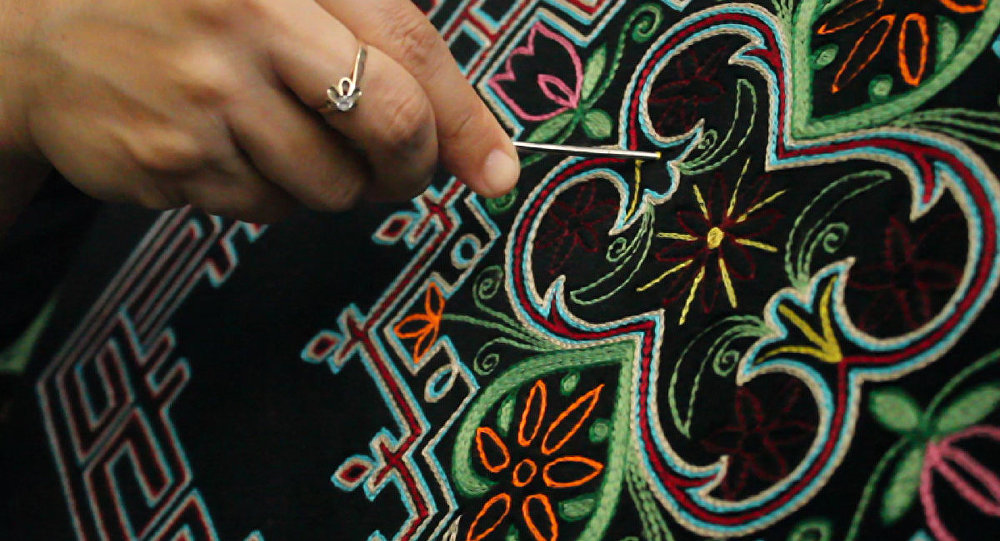
Azerbaijan created a rich and specific culture through the history of the Azerbaijani people. The decorative art was one of the most developed spheres of the culture in Azerbaijan. This art established in ancient times. It embraces different kinds of art including tattooing and jewellery, metal works, ornaments on wood, stones and bones, carpentry, weaving and ornamental knitting and weaving, knitting and other thread-works. All the types of the of this art reflecting the talent and moral world of the Azerbaijani people are widely used in the usual life of people.
The technique and composition of the thread-work of Azerbaijan date back to the remote past and proves the inheritance of the people. It is possible to define the time of the spread of different types of embroidery on the basis of different archaeological materials. The analogues of embroidery ornaments that are the right lines and polylines, zigzags, dotty ornaments, circles, triangles, rhombuses date back to the bronze era (3rd millennium B.C.).
A number of merchants, travellers and diplomats who visited these places in different periods of time provided interesting information about the development of Azeri art. Italian traveller Marko Polo stressed the beauty of the silk wares of Shemakha and Barda in the 13th century. English traveller -merchant Antoni Djenkinson wrote depicting the magnificence of the summer residence (the 16th century): "the king was sitting in the rich tent worked with silk and golden thread; his clothes were all in pearls and precious stones".
Darai and velvet were the most important local materials for the embroidery in the 19th-20th centuries. They were produced in Shemakha, Basgal, Sheki, Ganja, Shusha and other regions of Azerbaijan. The local silk and woollen threads and other patters were used in the embroidery. The plant dye-stuffs were used in dying.
The embroidery wares were distinguished for the richness and diversity of the ornamental motives. The plant motives as the image of roses, daffodils, pinks, tulips, lily, the leaves of the pomegranates, quince and cherry-plum trees as well as ears and leaves of different forms were the widest themes in the embroidery of Azerbaijan.
The geometric ornaments of the embroideries comprised the right and polylines, zigzags, triangles, quadrangles, six and eight-pointed stars, rhombuses and images of the Sun and stars.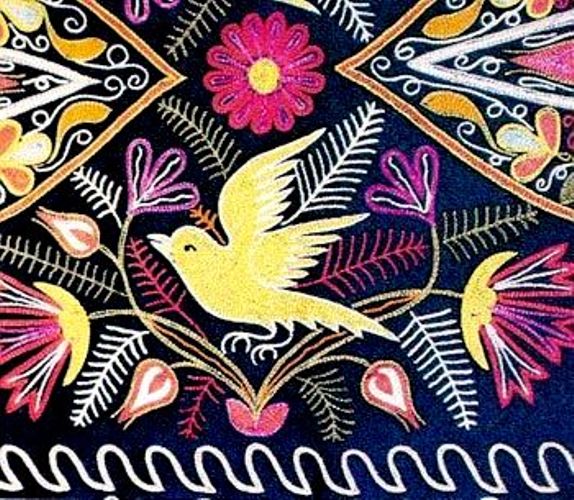
The people liked to embroider the nightingales, peacock, hoopoe, sparrow, pheasant, quail and others.
The widely spread image of two birds is the most favourite and ancient theme of decorative art. The birds are usually depicted either in love with each other or offended to each other. Both themes are reflected as love and parting. Among animals, the embroideries mainly contained the images of deer, tortoises, dragons and snakes, horses and others.
The most widely spread of the housing objects were the rails, containers for combs, boxes for cosmetics, jugs and others.
The most popular and widely spread types of embroidery were as follows: gold thread, plain embroidery, chain-stitch, embroidery with the technique "the birds-eye", metal pearls embroidery, pearl embroidery, stamping, "buttoning", flapping, spiral embroidery and work on the file.
The embroidery with golden and silver threads is the most ancient of all the types of embroidery. It mainly used thick cloths. Red, dark red, violet and green one colour velvet was considered the best material. Golden and silver threads produced at the factories were used in embroidery. This type of embroidery was called gold and silver thread.
The gold and silver thread was used in the decoration of the women's clothes, headwear, housing objects, saddles and other small objects. It was also a tradition to include the embroidery wares in a bride's dowry.
Chain-stitch was the most widely spread among the embroidery wares worked with colour threads.
Sheki was the centre of the chain-stitch in the 19th century.
Red, black and dark blue velvet and cloths of local or foreign production were mainly used for the chain-stitch. Not only women were engaged in this type of decorative art. A number of men also demonstrated their talent in this sphere. A master would first draw the contours of the picture on the cloth stretched by the loom and then filled its inner part. The needle used in chain-stitch was called qarmach.
The chain-stitch was used for decoration of the women's clothes, pillow-cases, mutakka, carpets used in the bathrooms.
Plain embroidery was another widely used technique of needle-works.
 This type of embroidery mainly used not bright, pastel colours mainly coloured silk and woollen threads in combination with golden ones. It had two types: two-sided and one-sided. Plain embroidery was used in the decoration of clothes, wall ornaments, curtains and others.
This type of embroidery mainly used not bright, pastel colours mainly coloured silk and woollen threads in combination with golden ones. It had two types: two-sided and one-sided. Plain embroidery was used in the decoration of clothes, wall ornaments, curtains and others.
"The bird's eye" -ornaments worked with white or coloured silk threads was one of the most widely spread types of embroidery.
Buttoning is found in the night headwear (shabkulag), janamaz and woollen clothes. Its simple and water sewing are carried out through laying the thin woollen or cotton layer between the prime and face of the ware.
The embroidery wares worked with pearls excited great interest and they have been in the decoration of costume elements and housing objects.
The embroidery with sparkling ornaments, pearls is the sewing along the contours of the image formed by the colourful silk threads on the cloths. The spiral embroidery is a relatively new type of needle-works.
The less widely spread drawn-thread work established very late and is seldom practised. It is mainly used for decorating of handkerchiefs, veils and napkins.
To date, Azerbaijan preserves the school of the art of embroidery that dates back to ancient times. The wares of this sphere of the art of Azerbaijan are demonstrated at the international exhibitions and in museums.
METAL GRAPHICS
Azerbaijan folk art has very ancient and rich traditions.

The work of arts made of metal mined in Nakhichevan, Mingechevir, Gedebey, Gazakh, Ganja and other regions are 5000 years old. Kitchen utensils, weapons and samples of accessories found in these areas should not only be treated as a historical fact but also as an important source which gives important information about mastership of the craftsman.
Copper, after its discovery in Azerbaijan in the period of eneolit plays an important role in the economic, agricultural, social and cultural life of the people of. After the discovery of lead, tin, manganese in Azerbaijan we experience the new and progressive age-the beginning of bronze age.
Material-cultural finds revealed during archaeological digs in Azerbaijan inform that our in the II millennium b. c. our predecessors widely used in their everyday life plates, delicate in form, daggers, axes, belts and other accessories made of bronze.
In spite of accurate elaboration and original forms bronze handicrafts made at this period were made without design. Among those monuments of the original form and accurate elaboration, we may name the figure of double-headed bronze deer found in village Dolanlar of Karabakh. In the past metal was generally used for the creation of artworks of religious character and it is possible that the deer was a totem the people of the whole territory worshipped.
Among bronze works of art of the ancient period, belt carries a particular importance for its high artistic value and mastering. The bronze belts revealed at the territories of Karabakh, Gazakh, Gedebey and other regions are striking with zoomorphic descriptions and designs on them.
Among works of art made of metal, one may found the patters with designs and descriptions on them, according which we may be informed of traditions, beliefs and clothes of that time population. Sealed bronze rings of the VIII-VII century b. c. found in Mingachevir tracts a great deal of attention. Described on the seals a man fighting with a lion, a fighter with a shield and a spear and a man worshipping the fire forms an idea of that time clothes and traditions.
The interesting point is that Strabon (63-19 b.c.) in the information given about the population of Caucasus mentioned the same clothes, weapons and everyday life implements here described. Metal processing at those times reached its high level in South Azerbaijan.
This is proved by samples of jewellery found in South Azerbaijan during archaeological digs.
Rare samples of art found in Hasanli, Garatepe, Ziviye and other places, located 70 km far from the lake Urmiya, are not only important materials about the history and the culture of ancient Azerbaijan, but they may also serve as an 'important document' which helped to solve the problems concerning the development of cultures of the Near and the Middle East.
Among works of art demonstrated in the museum of Archeology in Tehran gold basin, found from Hasanli hill draws particular attention. The descriptions on the basin are placed in two and three lines and cover the whole of it. The gold basin was found by an American archaeologist Robert Dayson, who resting on the descriptions refers the basin to the IX-VIII century b.c
Gold apron found in region Ziviya near the lake Urmiya, dated to the VIII-VII centuries b.c. proves the relation of the culture of Azerbaijan with neighbouring states. The apron is decorated with descriptions of a lion, a ram, a dog, a rabbit and a creature with a human head and lion body with wings.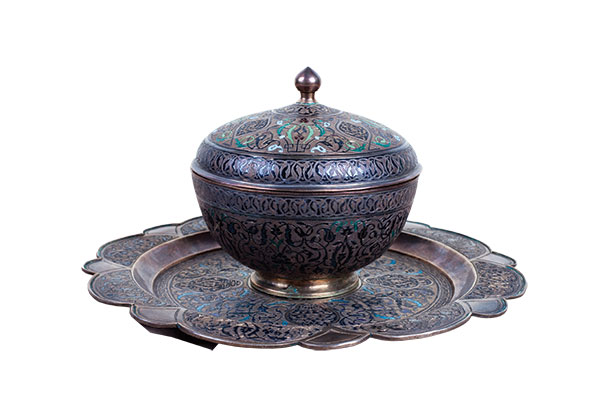
Among lively descriptions on the gold apron, special attention should be paid to the figure of lions with a human head. Or their general appearance, composition and style of elaboration they remind animals 'Shedu' raised in front of the palace of II Sargon in ancient Assuria. We must point that the monuments were raised in VIII-VII centuries b. c. All this also prove the development of Azerbaijan culture.
The middle ages are the richest period in the history of Azerbaijan folk arts. Among everyday implements of this period kitchen utensils, found during archaeological digs in Mingachevir and kept in the Museum of Azerbaijan History in Baki are especially important. Among those utensils, silver plates are specially distinguished with their delicate designs and beautiful forms. Constantly repeated lines-relieves make the plate more interesting. As bas-relieves, they reflect the light and the shade and thus composes the whole thing. Delicate aftafa (a jug used for ablution)kept in the museum of Azerbaijan History was also decorated in this style.
Among traditional everyday implements, we man mention bronze tray (mejmei) found in Dagestan and in present-day kept at the Hermitage in Saint-Petersburg. The descriptions of lower, bows and their general composition on the tray made by forging are considered for its original style to be the pattern of the VI-VII century. Ornamental motives of plants are described on a great medallion in the centre of the tray
Not only everyday implements were made of metal by Azerbaijan masters, but tender pieces of jewellery as well.
Parts of gold and silver belts, rings, bracelets and other accessories found during archaeological digs in plain Mil, Gabala, Mingachevir, Nakhchivan and other places show that jeweller's art in Azerbaijan was in a high level of its development even till the beginning of the middle ages. Those works of art decorated by most difficult techniques of jewel's art: shebeke (tracery), basma (blotting), gelem ishi (pen-work)and others are characterized with the original form and delicate elaboration.
The interesting fact is that designs on the works of art of that period, for example, crescent, five-point star and other motives remained up to our days and are used by masters even today.
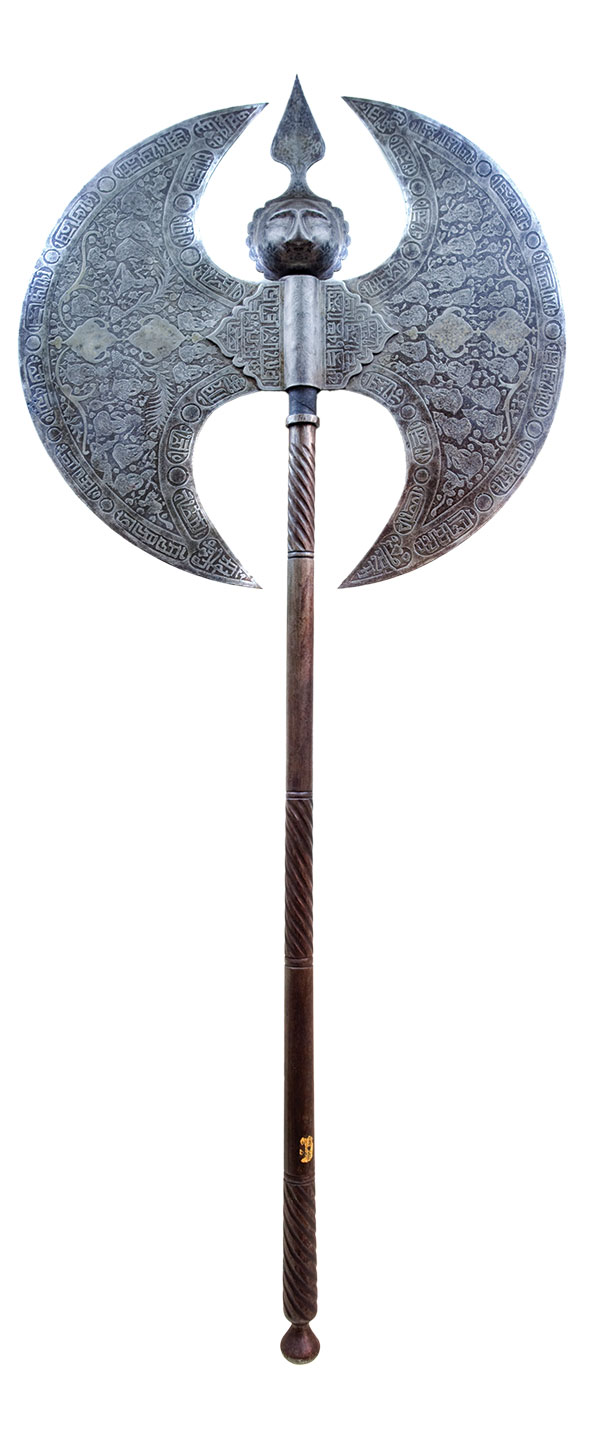
The XI-XV centuries are characterized by the process of the high development of the art of metal in Azerbaijan. Many weapons, house equipment of different shape and other samples of art were made during this period, most of them remained till our days. As in the past, Ganja, Shamakhi, Nakhchivan, Tabriz preserved their fame as the centres of metal products. Archaeological digs prove that in the XII century and later Baki also occupied a particular position in that sphere.
Among metal monuments made at that period the most attractive one is bronze Shirvan tube (lulak), the work of 1206 kept in the State Hermitage in Saint-Petersburg. It is difficult to understand at first sight that it is a water bowl. As it is composed of the monuments of small animals. The composition is created in the format stylization. The surface of the bronze tube is decorated with silver in the techniques of scratching and cyclization. Among the ornamental designs of Shirvan tube, one may notice historically-important scripts. One of the scripts reflects the name of the master of the tube -'Ali Mahamed oghlu'.
Metal equipment found together with the works of art of that period also draws particular attention. Those samples were revealed in the result of archaeological digs in of reservation of Shirvanshah palace in Icherisheher(the Inner Town). Bronze figurative lamp found among the same metallic samples.
The lamp is thoroughly covered with different descriptions in the technique of bas-relieve. Those are the real descriptions of a horse, two bulls, fourteen heads of cats and two human faces.
Bronze brazier of the XIII-XIV centuries found in the region of Guba may also be referred to monuments of Shirvan area. It has the form of half-sphere, the height is 30 cm, the length at its mouth is 131 cm, the diameter is 41 cm and original form and ornamental designs. The scripts on the brazier say that it was made by a copper-smith Ahmad Mahammad oghlu. The cities of Azerbaijan such as Beylagan, Ganja, Nakhchivan and Tabriz were main centres of the art of metal of that period.
It also proved by works of art revealed at those regions in the result of archaeological digs. Among works of art referred to these zones bronze monuments of a human and birds, found in Beylagan(Oran-gala) bronze can be made by Osman Salman oghlu Nakhchivaniin 1190 and kept in Luvr in Paris attract much interest.
As it is seen from named patterns the majority of metal implements used in everyday life were made of bronze.
Metal art was particularly developed in Tabriz in the XIV-XV centuries. Famous traveller of Venice Marko Polo, visited Azerbaijan in the second half of the XIII century spoke about the hugeness of Tabriz and the position,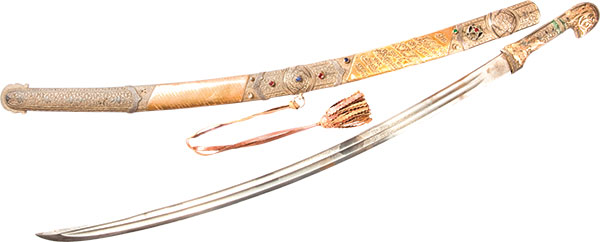 it occupied in development different spheres of the art. Today many prominent museums of the world exhibit a lot of original patterns of metal art made in Tabriz at this period of time. A figurative bowl made by Yusif ibn Ahmed Tabrizi in 1319, kept today in Victoria and Albert Museum of London and a bronze tiyan, kept in the State Hermitage of Saint- Petersburg should especially be mentioned.
it occupied in development different spheres of the art. Today many prominent museums of the world exhibit a lot of original patterns of metal art made in Tabriz at this period of time. A figurative bowl made by Yusif ibn Ahmed Tabrizi in 1319, kept today in Victoria and Albert Museum of London and a bronze tiyan, kept in the State Hermitage of Saint- Petersburg should especially be mentioned.
Tiyan made by Abdul Aziz Sharafaddin oghlu in 1399 in Tabriz is the most interesting work of art among those reflecting national traditions of the mentioned period. With the weight of 2000 kg and a diameter of 2.45 sm this work of art is considered to be the greatest tiyan known in the East World. Tiyan draws attraction not only for its incomparable size but also for its artistic construction. On the front part, tiyan is decorated with beautiful designs of plants. Among the designs, there is a script about that the monument was made by Abdul Sharafaddin oghlu in 1399 in Tabriz on demand of Teymurleng for the mosque Khoja Ahmad Yasevi. One may also find the script 'The ruler of the world is Allah' one after another 22 times repeated along with the whole kettle.
There is the specimen proving that Tabriz was not the only centre of metal art, as during and after that period this kind of art was also developed in other cities of Azerbaijan. Today Mr. Harari, keeps in America in his personal collection an original bronze istirlab, referred to the XV century. According to notes made on this tool, used in astronomy, it was made by the famous master of Shirvan Shukrullah Mukhis in 1468. Being a highly technical instrument, this istirlab amazes with designs on its surface.
In the XVI-XVII centuries preparation of metal house equipment, weapons and accessories were especially developing in Tabriz, Ardabil, Maraga, Nakhchivan, Ganja, Shamakhi and Baki. Weapons (daggers, swords, topuzes and shield) and armoured clothes(bashlyk(hood),elbow-rest, breeches) made by masters of Azerbaijan were very famous abroad at that period.
In Russian sources, we often come across the names of weapons made in Shamakhi. In one of such materials, we learn about 8 decorated hoods of Russian tsar Boris Godunov, made by the masters of Shamakhi.

The fame of Azerbaijan weapons at that time was not accidental. Local masters invaded many new ways in the preparation of the weapons.
The XV century replaces so well known straight and wide swords with a crook crescent-like swords with the handle made of gold, silver and valuable bones.
The appearance of shields and armoured clothes were richer and more magnificent than before.
A shield referred to the XV century kept in the house of weapons of Kremlin draws particular interest. With its amazing beauty, this shield protected a Russian tsar M.F.Romanov during the war. Then it passed to famous Russian warlord F.I.Mstislavski, and in 1622 after his death, was presented to the treasury of Russian tsars. Its diameter is 50,8 cm, was forged of the whole red steel and covered with gold by the technique of khatemkarlig.
We may stress two more samples made in Azerbaijan at that period. both of them are the hoods used by the nobles during wars. One of them is now kept in Moscow House of weapons, the second is kept in Istanbul. The second hood carries a script, noting that it was made for Shah Tahmasib in 1528.
The first armoured hood is first named in the list of weapons brought to Boris Godunov from Shamakhi. Later this helmet was kept as a figurative pattern by knyaz (prince) F.Mstislavski.
The abovementioned sample is so filled with decorations that it nearly looks like an arakhchin with gulabatin needlework, then a hood protecting the head from the stab of the sword, mace and so on.
One may notice the samples of calligraphy among decorations of the hood. They are placed in a wide range on the forehead of the hood. They are the words: 'For the sake of powerful and merciful Allah'.
The hood was made of smoothed steel and decorated by means of three techniques of metal processing: tracery (shebeke), khatemkarlig and pen work.
Jewels may be referred to as an inseparable part of samples of metal art of the XVI-XVII centuries. They were generally made of gold and silver and used as accessories for men and women.
The golden and silver accessories made of precious metal were of 4 kinds according to their usage: 1-accessories for neck, 2-those for arm and fingers, 3- for the head,4- and those attached on the clothes.
Two work should be mentioned among the jewellery made in this period and preserved up to our times. One of them is a silver decorated necklace in the form of almond and corns of pomegranate found among Safavi coins during archaeological digs in region Gedebek, the second one is the gold waistband of I Shah Ismayil referred to 1507.
Shah Ismail's waistband is of particular interest. Today it is kept in the palace of Topgapi of Istanbul and considered one of the richest and most decorated among all the waistband for men. Ornamental designs of the plant on the waistband are alike those met on the carpets, cloths and other works of art of the period. The most beautiful part of the waistband is its belt. Being in the form of a circle, the belt has the real descriptions of a young noble on the horse going for hunting and a guide accompanying him.
According to general composition and separate motives descriptions on the belt remind of some subjects in the art of miniature of the time.
The most developed sphere of art developed in the XVIII in Azerbaijan was the coppering. Foreign travellers inform that special streets of coppering were in the cities of Tabriz, Ganja, Sheki, Shusha, Shamakhi, Baki where masters made decorated, original kitchen implements.
There were zones in Azerbaijan where the major part of the population was busy with that sphere of art. One of such places was Lahij, included in the khanate of Shamakhi at that time.
Everyday life and house implements (such as can, satil, aftafa, sernij, copper tray (mejmeyi), serpuz, etc.) were made in Lahij at the period. Products of Lahij was as well in quality and quantity as the products made in central cities of that time.
Among preserved up today metal products made in Lahij samovar of the XVIII century carries particular interest. Its has correct proportions, beautiful form and decorations on it. The decoration consisted of stylized descriptions of plant, zoomorphic and human. The majority of designs used in the decoration of the samovar are found on many samples of Azerbaijan folk art(i.e. on walls and stones, cloths, fancywork, etc.). The samovar was made of copper and decorated by the settler of the village Lahij, a copper-smith master Najafgulu in 1130 according to the calendar of hijri-gamary (in 1717 according to the calendar of Christianity).
Sheki also was among those popular for the production of metal house equipment and accessories in the XVIII century.
As to the sources, the masters of Sheki were famous for making cast decorated brazier.
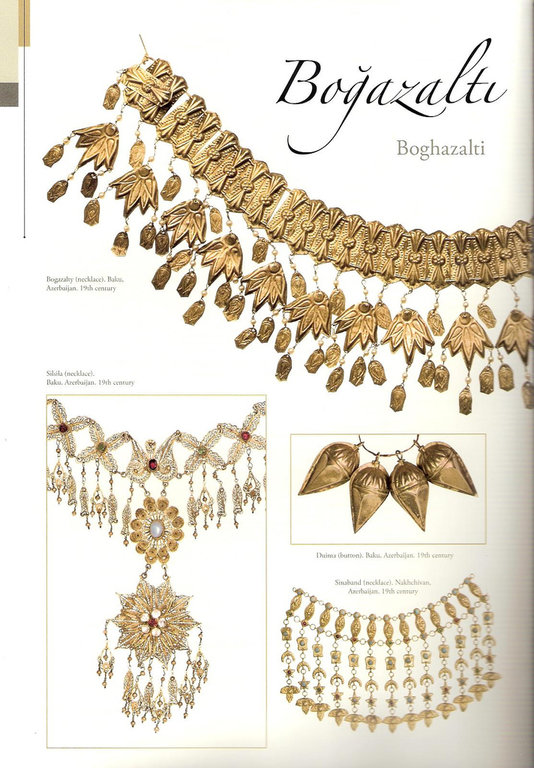
Those braziers were not big in size. Majority of them consisted of 6-8 cast bronze parts hooked to each other with. On those bronze pieces, you may fund the ornaments of plants, geometric figures, and figures of birds and animals worked by bas- relief.
The composition of 'Islimi', a curved line with attached flowers and leaves was the popular one among plant designs, as well as the figures of nightingales and lions faced each-other.
Many of the patterns of the jewellery of the XVIII century had been preserved up today.
The most popular women accessories used by women were necklaces. Among them were sinebends, bogazaltis, chechiks, garabatdags and others.
Those accessories were made by attaching valuable beads, purls or pieces of gold and silver in the form of pakhlava(rhomb). In the majority of the cases or better look of those accessories, around the second part with the description of the net on it was attached to it to cover the chest. Sometimes this circle was replaced with a 6, 8 or 12 point star, worked in the technique of tracery, galam ishi or other, in the centre of which there were ruby or turquoise and a crescent under it.
Two same woman head-dresses, kept in the museum of country-studies in Zagatala are among the best patterns of jewellery made in this century.
At first sight, the abovementioned head-dresses look like a helmet.
The bashlig (hood) is composed of silver pieces of different form and size attached to each other by means of circles. In order to be far from monotonousness decorated with precious jewels, round plates are placed between the silver pieces. They are placed at the sides and at the top of the bashlig. The most beautiful part of bashlig is a tender figure of a crescent and star attached to the tube raising up off its top.
The waistbands made for women and men made at this period of time again prove that the patterns of jewellery were related to old traditions.
In the past waistband was an inseparable part of women and men clothes, which might give the information about the position, wealth, religious belief, nationality and age of its owner.
The waistband in the XVIII century was used both by men and women. The waistband for women was wide, while that for men was thin.
The waistbands of this period were made of figurative and decorative pieces of bronze, silver and gold. The most beautiful part of them were the belts. The belts generally were in the form of square metal decorated in the technique of shebeke (tracery), gelem ishi (pen-work)and sometimes decorated with precious jewels. Women attached 23 lines of gold and silver coins or the accessories in the form of buta or pakhlava (rhomb) to the lower edge of the waistband when men attached several decorated with different figurative metal pieces thongs hanged over the lap
One of the popular kinds of waistbands in Azerbaijan in the XVIII century was 'cherkezi kemer (waistband)' for men. In some cases those waistbands had metal figures of pakhlava, circle and sometimes horses and rams facing each other and other samples decorated by the technique of garasavad and blotting.
House equipment, weapons, accessories made of metal in XVII century Azerbaijan were decorated by 6 techniques: forging, blotting, garasavad, shebeke (tracery), khatemkarlig (ring-making) and minachilig (glaze-covering).
Forging is one of the ancient techniques. It the easier than other techniques of the art. It demands sharp eyesight and great skill. The masters work with hammer and sharp-tip tools.

In the technique of blotting a piece of gold, silver and any other precious metal is placed on a high mould with decoration or design in the form of relief. Then the piece of precious metal is covered with a piece of lead of the same size and the masters begin to strike on it with a wooden hammer and the precious metal takes the necessary form. This kind of technique is generally used in making of the waistbands, buttons, bracelets and others.
Garasavad was mainly applied on silver, for in dark tone silver gets clear and white lines. On the surface of forged smooth silver masters drew come description by means of scratching and covered its sides with a black substance. Generally, the accessories(waistbands, daggers, pistols, gun powder-boxes and others )were decorated by this technique.
Shebeke is the description or a design made by a thin winding string. Two forms of shebeke are known: the first constitutes the thing with gold and silver strings, the second decorates the same thing.
Khatemkarlig has a great heritage in the jeweller's art o Azerbaijan. To decorate dagger, swords and other samples of art the surface of the thing is slightly drilled by cheshni, appeared holes are filled with gold, silver and other non-ferrous metal nails. After the process is completed, the surface of the thing is smoothed and gets the form of a beautiful mosaic.
One of the most difficult and interesting branches of this technique is scraping a script or a picture on the thing with non-ferrous metals. The master should have great taste and skill to do it. Azerbaijan artists were very skilful in that sphere of art.
Minachilig was one of the ranches of the art which took Azerbaijan jeweller's art to its highest level. Perdeli mina as one of the difficult and interest braches of minachilig, was widely spread in Tebriz, Nakhchivan and Baki.
The technique of this branch of art is to fill an engraved picture or a design with colourful liquid(glaze) named mina. Users of this technique by means of blotting copied the design (bird, animal, plant, etc.) described on the mould on to a piece of gold, silver and other metal and filled the spaces with mina.
The most frequently used colours in minachilig were rosy, green, blue, turquoise, black and red.
In comparison with minachies of the other countries, the works of minachies of Azerbaijan were the most popular ones, for they did not use mixed or muddy colours in their works. Each of the colours used by them to fill in the paces had their own peculiarities and were separated from each-other with a golden or another sting. Majority of colours in Azerbaijan minas and the harmony between them strikes everyone.
At the beginning of the XIX-XX centuries, 3 kinds of metal art were developing in Azerbaijan. They were the profession blacksmith, coppering and jeweller's art. The blacksmiths made the agricultural tools and everyday equipment: a brazier, tripod, door handle, tongs and others.
The art of coppering having a great heritage in Azerbaijan was preserving its particular place during those ages. Depending on the peculiarity of everyday life and their economic engagement of people of Azerbaijan there was a great need in the country for a pot, a pan, a serpush (plate cover to keep the food hot), a sernish (milking), a tray, a satil (bucket), an aftafa, a seheng(a long jar with long neck to carry water), a can and other things made of copper
In comparison with other samples of metal art, jeweller's art preserved the traditions of the past. Rings, earrings, bracelets, sinebends (collars), waistbands and others used by Azerbaijani women were again in fashion.
Minali earrings made by jeweller's of Baki and Shamakhi, the accessories for neck and chest made by the masters of Ganja and Sheki in the technique of shebeke and decorated with jewels gold combs, glassy waistbands made by Shuha masters still amaze everyone.
By the way, Lahij was included in the UNESCO Intangible Cultural Heritage List in 2015.

